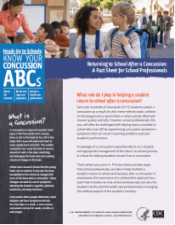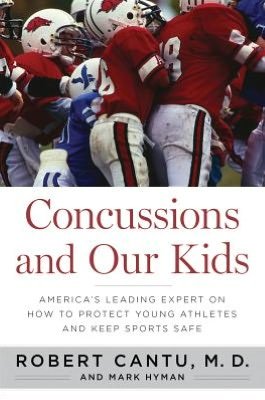First responders: concussions no easy task
- Created on Thursday, 24 May 2012 17:30
- Last Updated on 07.02.2013
- Published Date
SEQUIM, Wash. -- Battle-tested and a little weary from last fall’s high school football season, Travis Anderson, an experienced EMT and paramedic John Riley, understand the nuances of concussions. Athletes who — if they are conscious – say they are ‘fine,’ coaches who may not be sure an athlete needs medical attention, and parents told by ER staff that rest is the prescription for recovery, trying to make sense of the mountain of hospital medical bills.
They’ve seen it all, and it’s not easy.
First responders like Anderson and Riley from Clallam County Fire District #3 in Sequim, Wash., are a luxury for school districts around the country. Part of a crew made up of paid staff and volunteers, they wait in the corners until given the signal by a coach or referee, or a player goes down and stays there.
Like other on-field personnel they can’t see every impact and don’t always know if an athlete is deteriorating on the bench after a big hit. They depend on an educated coaching staff and fellow teammates for their cues.
Anderson said,”We’d like to be called sooner rather than later. If there’s any question, especially with a suspected concussion, call us.”

Too little care
Only about 42 percent of high schools nationally employ athletic trainers, a dismal number in the eyes of many concussion experts who continue to advise against any school district or private organization offering contact sports without proper sideline medical care.
Given the budget crises facing many school districts, it is not surprising so few heed this advice.
But the challenges in rural areas are even greater. Long distances separate football fields from hospitals and fire stations can serve several high schools. Resources are simply too lean.
Many sports-related concussions
“Our fire department provides sideline staff for high school football games, and as many junior varsity games as we can. We consider it part of our community service effort and quite frankly, we feel strongly about protecting our student-athletes and their futures,” said District #3’s Fire Chief, Steve Vogel. His first responders have been on the sidelines at Sequim School District's games since 1982.
Chief Vogel’s staff has a long history dealing with sports concussions. Former Sequim football player Adrien Gault suffered a catastrophic brain injury during a game in 2006 and was airlifted to a Seattle trauma center where doctors gave him a four-percent chance of survival. He continues to work through his recovery.
This past fall, a Sequim student suffered a brain aneurysm during a Friday afternoon PE class and died a few days later. That same Friday there were six significant concussions on the football field a few hundred yards away, said a well-informed source, turning the field into a war zone.
Fire District #3 was there for it all. “There were more concussions during that one game than I’ve seen in my entire career, including my time as a running back in high school,” said Anderson. “It was a rarity.”
Neither he nor Riley, who played tight end in high school remember suffering concussions during their football careers. They believe they’re seeing so many due to increased awareness trickling down from the NFL. Anderson said, “I think the attention on the concussion issue in the NFL is having an affect on all levels of the game, all the way down to the youngest players.”
Emergency Medical Services for Children (EMSC)
Guidelines and training for first responders come in the form of online education modules and concussion-related drills practiced several times a year.
Soon-to-be-released state protocols developed by emergency room physicians, critical care nurses, EMTs, and others who make up the state committee of the federal Emergency Medical Services for Children program include a sports-concussion guide for first responders. Upon distribution, this document will provide a handy reference for those who attend youth and high school athletic events.
“The Emergency Medical Services for Children (EMSC) program works to ensure proper pediatric care is available on ambulances and in hospital emergency departments nationwide,” said Ian Weston, Co-Director of the EMSC program headquartered in suburban Wash. D.C. “Emergency care providers are integral in ensuring our children get the right care when it counts.”
When to call 911
Concussion symptoms can be subtle and may not appear right away, leaving room for mistakes to be made if athletes are not properly monitored when a concussion is suspected. The following are symptoms that require a call for emergency evaluation:
•headaches that worsen
•seizures
•neck pain
•very drowsy, can't be awakened
•repeated vomiting
•increasing confusion or irritability
•weakness, numbness in arms and legs
•unable to recognize people/places, less responsive than usual
For more information see Should we call 911?, signs and symptoms
Photo: (L) John Riley (firefighter/paramedic); (R) Travis Anderson (firefighter/EMT)
Questions/comments? contact Jean Rickerson at This email address is being protected from spambots. You need JavaScript enabled to view it.
Brain Health
It is rare for a sports-related concussions to result in a more serious injury such as a skull fracture or hematoma. Nonetheless, it pays to be aware that catastrpohic injuries do sometimes occur as ...
read more...-
CT scans may increase brain cancer risk
Children and young adults scanned multiple times by computed tomography (CT), a commonly used dia...
-
Sub-concussive impacts may affect learning
MINNEAPOLIS – A new study suggests that head impacts experienced during contact sports such as ...
-
Physical activity boosts learning
INDIANAPOLIS – School administrators looking to restructure the academic schedule should consid...




Neuroscience
Athens, Ga.- University of Georgia researchers have developed a map of the human brain that shows great promise as a new guide to the inner workings of the body's most complex and critical organ.
...
read more...-
Does CTE infect neuron to neuron?
NFL Hall of Famer "Iron Mike" Webster's life ended in 2002 when he suffered a heart attack at age...
-
Progesterone seems to protect neurons after injury
It is not yet known why girls suffer concussions at a higher rate than boys. The most prevalent...
-
Amino acids may restore concussion's chemical imbalance
Concussions are often called the "invisible" injury because they are usually not detectable by t...
Resources
- School professionals play an important role in the health of all students. Recognizing the signs and symptoms of concussion is important, as is managing their return to school ...
- https://
- CDC's Concussion Training for Clinicians
-
Concussion Education Video Programs - Free and Easy
Parents, athletes, coaches and medical professionals have access to concussion education created...
-
New concussion guidelines for team physicians
INDIANAPOLIS – Team physicians who assess and treat athletes suspected of concussion have new ...
quick links
Latest News
Concussions Occur...
...in Any Sport
REMOVE athlete from play
REFER to medical provider
REST no sports, no texting/TV
RETURN only with doctor's OK
Source: Children's Hospital Boston, Sports Concussion Clinic


































